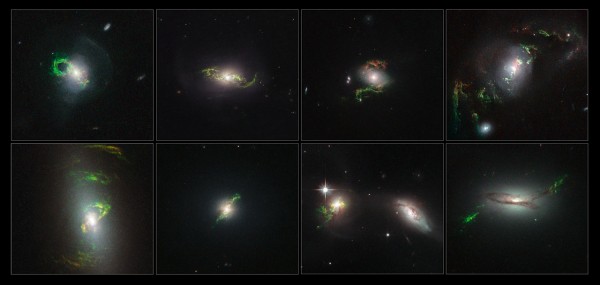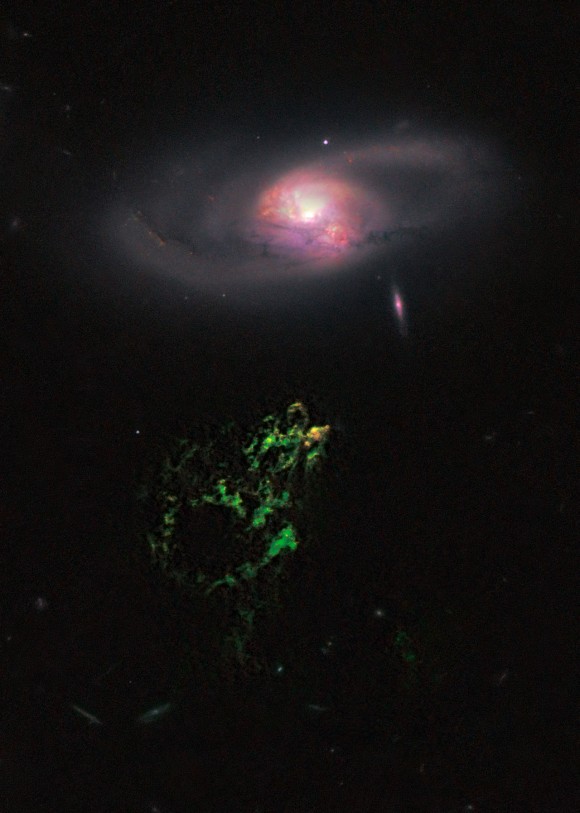
Quasars are thought to be luminous and compact regions surrounding the supermassive black holes of distant galaxies. Their extreme luminosity – intrinsic brightness – is what makes them so compelling to astronomers. That’s because, to be so distant and yet still so visible, these objects must be exceedingly powerful. This week (April 2, 2015), the NASA/ESA Hubble Space Telescope team announced a new set of images of what it calls enigmatic quasar ghosts …
… eight unusual looped structures orbit their host galaxies and glow in a bright and eerie goblin-green hue.
NASA said these green wisps are thought to have flickered to life and then faded and that they offer new insights into the turbulent pasts of the galaxies containing the quasars.
Astronomers think that blasts of radiation from a quasar illuminated these ethereal wisps, perhaps briefly. Quasars’ great luminosity is thought to stem from galactic material falling inwards towards a galaxy’s central black hole. The materials heats up as it falls and forms a bright and brilliant quasar. But the quasars isn’t radiating equally in all directions; instead, powerful jets or beams of particles and energy extend above and below the quasar. This quasars jet or beam sweeps through space, like a lighthouse beam.
It’s thought that each of these eight images represents once-invisible filaments of gas in deep space, made to glow by a passing quasar beam. This would happen through a process called photoionisation, whereby oxygen, helium, nitrogen, sulphur and neon in the filaments have absorbed light from the quasar and slowly re-emitted it over many thousands of years. NASA said:
Their unmistakable emerald hue is caused by ionized oxygen, which glows green.
These ghostly structures are so far from the galaxy’s heart that it would have taken light from the quasar tens of thousands of years to reach them and light them up. So, although the quasars themselves have turned off, the green clouds will continue to glow for much longer before they, too, fade.
Not only are the green filaments far from the centers of their host galaxies, they are also immense in size, spanning tens of thousands of light-years.
They are thought to be long tails of gas formed during a violent past merger between galaxies — this event would have caused strong gravitational forces that would rip apart the galactic participants.
Despite their turbulent past, these ghostly filaments are now leisurely orbiting within or around their new host galaxies. These Hubble images show bright, braided and knotted streams of gas, in some cases connected to twisted lanes of dark dust.
Dutch schoolteacher Hanny van Arkel found the first object of this type in 2007. Astronomers labeled it heic1102). Van Arkel discovered the ghostly structure in the online Galaxy Zoo project, a project enlisting the help of the public to classify more than a million galaxies catalogued in the Sloan Digital Sky Survey (SDSS).
The bizarre feature was dubbed Hanny’s Voorwerp (Dutch for Hanny’s object).
The eight new objects recently observed by the Hubble Space Telescope were also found via Galaxy Zoo, in a spin-off project in which about 200 volunteers examined over 16,000 galaxy images in the SDSS to identify the best candidates for clouds similar to Hanny’s Voorwerp.
A team of professional astronomers later analyzed the volunteers’ work and found a total of 20 galaxies that had gas ionized by quasars.
Their results appear in a paper in the Astronomical Journal.
EarthSky’s annual fund-raising campaign is coming into the home stretch. Help EarthSky keep going!

Bottom line: Volunteers and professional astronomers worked together via Galaxy Zoo to identify 8 etherreal wisps orbiting distant galaxies, thought to have been illuminated by a blast of radiation from a quasars.











